Introduction
Specifications
At the beginning of 2015, Canon simultaneously launched not one but two entry-level models based on the same sensor and chassis. Known outside of North America as the Canon EOS 750D and EOS 760D (Rebel T6i and T6s, respectively), the latter, equipped with a top-plate LCD and control dial on the rear, is aimed at more serious users. Both models, however, use the same new 24-Mpix APS-C CMOS sensor with a low-pass filter and feature Canon’s Hybrid CMOS AF III system. This elaborate sound system supplements contrast-detection AF with sensor-based phase-detection points for faster, more responsive AF when the mirror is up during live view and video capture. With the mirror down, the EOS 750D/760D models adopt the 19-point, all-cross type, and mirror-based phase-detection AF system that was first introduced in the original EOS 7D. As a camera aimed at the more advanced user, the EOS 760D adds Servo AF in live-view mode, allowing the AF system to track subjects during live-view operation.
Besides those few differences, as the cameras share the same sensor and supporting electronics, they essentially deliver identical image quality. Choosing lenses for the two models is a somewhat complicated affair, particularly if wanting to use fixed-focal-length lenses. Canon, like many manufacturers, doesn’t offer a complete range of primes designed specifically for APS-C models. Instead, the expectation is to choose either full-frame lenses, or opt for a zoom. While there are a proliferation of zooms made for APS-C, choosing a full-frame zoom or prime often means paying more for a lens that’s designed with a wider field of view and often for a different purpose.
While this isn’t so much of an issue with focal lengths of 50mm or above, it is a limitation with shorter focal lengths, where increasingly complex (and expensive) lens designs are required to achieve a more extreme field of view. Although this isn’t limited to Canon, the company is updating its older, more accessibly-priced fixed-focal-length models with newer higher-end lenses aimed at enthusiasts. As a result ,there are a number of pricey models from Canon, but accessibly-priced options are available from third parties such as from Sigma and Samyang, especially.
Best wide: Samyang 16mm f2.0 ED AS UMC
As a lens made specifically for the smaller APS-C sensor, the Samyang 16mm f2.0 ED AS UMC is more compact and lighter than those such as the Zeiss 2.8/15 (15mm f/2.8), which was made to project a far larger image circle (enough to cover a full-frame 35mm sensor). On the Canon EOS 750D/760D, it’s the equivalent to a 26mm, whereas the wider Zeiss has an angle of view similar to a 24mm. There are other compromises as well. The Samyang lacks electronic coupling, so the lens must be stopped down manually. And there’s no data shared between the camera and lens. All the same, at just $479, it seems reasonably-priced, and with a DxOMark score of 20 points, it’s the best-performing ultra-wide prime in our database and arguably the best value for the EOS 750/760 (unless you also have or intend to add a full-frame model in the future).
As a full-frame model, the Zeiss is the best-performing lens in this category, though the APS-C Samyang 16mm has the edge on sharpness, at least peak sharpness. Despite that, the Zeiss 15mm 2.8 model is an outstanding performer, even if it’s beyond the reach of the intended market of the cameras. It has excellent sharpness across the field from f/5.6, and it has low vignetting and chromatic aberration and excellent control of distortion.
In third place is another Samyang, the 14mm f2.8 IF ED UMC. As a full-frame lens, it’s a rather extreme model, which would normally make it difficult to justify for cameras like the Canon EOS 750/760D, but at just $379 it’s much more accessible. Again, there are compromises: like the 16mm, it’s manual-focus only and there are no electronic contacts, so there’s no automatic aperture control, and metering is stopped-down only. Optical performance is unusually good, given the price, but distortion is high, and given that it borders on complex-type, it is difficult to correct.
Best normal: Sigma 35mm f1.4 DG HSM Art
Like rival Nikon, Canon still doesn’t make much provision for APS-C camera users with wide or ultra-wide models specifically for the smaller format, which is a surprise, given manufacturers’ woes. Because of that, there’s no equivalent to the $499 Sigma 30mm F1.4 DC HSM — another Art series model, but one that doesn’t quite perform as well as well as the full-frame 35mm version. Despite the lack of accessibly-priced models (or perhaps because of it), there are some excellent performers.
The three best-performing models in our database include the two current 35mm models from Canon and the Sigma Art series 35mm F1.4. Both that and the stabilized Canon 35mm f/2 IS share the same ranking in our database, but the faster (and pricier) Sigma has marginally higher sharpness across the field at most apertures, even if the two have similarly low distortion, vignetting, and lateral chromatic aberration (though bear in mind that the Sigma is a f/1.4).
Introduced back in 1998, the Canon EF 35mm f1.4L USM was designed for Canon’s film-based EOS bodies. Today it’s still a good performer, especially once stopped down, but it’s not quite as sharp as the Sigma until f/8, and it has high levels of chromatic aberration throughout the aperture range (not just at lower f numbers). A new version has been announced which is likely to change the rankings, but at $1,800, it’s unlikely to appeal to the typical EOS 750D/760D user.
Best performing short tele: Zeiss Distagon T* Otus 1,4/55 and Apo Plannar T* Otus 1,4/85
In this category, there are some recently-introduced full-frame models that have been designed without compromise. The Zeiss Otus 85mm f/1.4 and 55mm f/1.4 are, unsurprisingly, the best performers, but their high price is at odds with the relative affordability of the EOS 750D and 760D. In third place is another model from a third party that challenges Canon’s well-deserved reputation as a premium lens maker. At $949, the Sigma 50mm f/1.4 DG HSM A is still pricier than the Canon equivalent (listed in 9th place), but that’s an old model originally designed for film, and is long overdue an update. When it arrives, we fully expect it to be on par with the Sigma in quality and most likely in price as well.
In the meantime, although they’re an unlikely choice for cameras like this, the three best-performing models are what are they are. The sharpest model is the Zeiss 85mm f/1.4, but both the 55mm f/1.4 Otus and Sigma 50mm f/1.4 follow closely. What stands out is the uniformity of the Zeiss across the frame, right out to the corners. Most of the gains over the Sigma are in the outer field, at least at wider apertures. Stopped down to f/2.8, there’s little between them in sharpness. In the lab the Sigma, surprisingly, has less lateral chromatic aberration, but anything below 10 microns is considered low anyway.
However, whereas the manual-focus Zeiss models are clearly targeting well-heeled enthusiasts and professional photographers, the less lust-worthy Sigma appeals to a wider audience, and with the added attraction of autofocus, is arguably the more sensible choice for most users.
Best value short tele: Canon EF 50mm f1.8 STM and Canon EF100mm f2 USM
For those on a limited budget or one more in line with the intended market of cameras like this, the new Canon EF 50mm f/1.8 STM is a particularly fine performer on APS-C (listed in 8th place) at just $125, and the Canon EF 40mm f/2.8 STM (not listed in the top 10 in the table below) at $249 is super-compact and lightweight. The latter secured a DxOMark score of 20 points and peak sharpness of 11 P-Mpix and is highly regarded for its attractive drawing style. With a slightly longer focal length. the EF100mm f2 USM in 7th place is great performer optically, including when wide-open, and at $440, it remains a competitively-priced offering in Canon’s huge full-frame line-up.
Best-performing telephoto: Carl Zeiss Apo Sonnar T* 2/135
Anyone looking to reaffirm their purchasing decisions regarding the Zeiss Apo Sonnar 2.0/135 T* ZE can rest assured that it’s the best-performing telephoto model on the Canon EOS 750D/760D, but even as the equivalent to a 200mm f/2, bear in mind that it is manual-focus only and will set you back $1,600. It has outstanding sharpness across the frame from the initial aperture up to f/8, after which you can see the effects of diffraction. Peak sharpness is reached at f/4, but it is the combination of low chromatic aberration and uniform sharpness across the field that makes this model such an exceptional addition to the range (and at well under half the price of either of the two Otus models).
In second place, Canon’s recently upgraded EF 300mm f/2.8L IS USM is a $6,600 model boasting a twin-fluorite element design for improved balance and reduced weight (not to mention lower chromatic aberration on higher-resolution sensors when viewed on-screen at 100%). It has even higher peak sharpness than the Zeiss, though somewhat surprisingly, it doesn’t quite match the peak levels of its predecessor when stopped down. Despite that, it has superior sharpness and uniformity of sharpness wide open, and it has better sharpness in the outer field at f/4 over the earlier model (this should also be a benefit when used in conjunction with a teleconverter).
Following closely is Canon’s highly-regarded EF 135mm f/2L USM. With sharpness not far off the Zeiss equivalent, at least in the centers, and with almost equally low lateral chromatic aberration, this high-speed AF model is more accessibly-priced and arguably more suited to the EOS 750D/760D models. It doesn’t have the uniformity of the Zeiss, nor can it match the lower transmission, but it’s unlikely to disappoint.


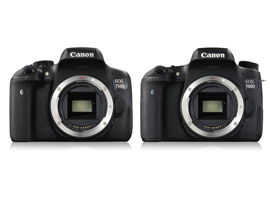
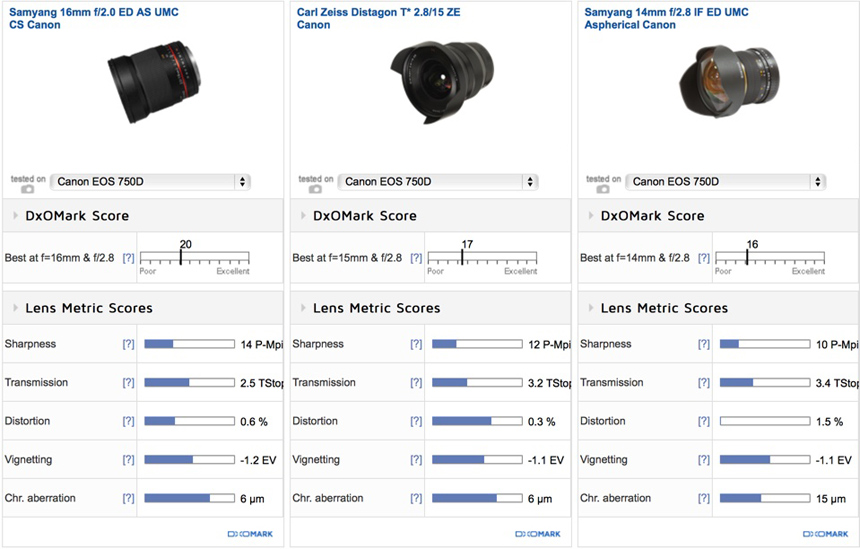
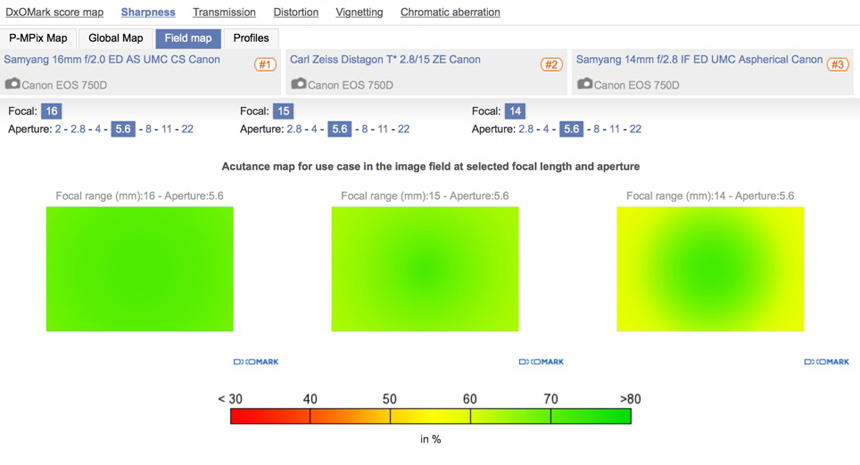
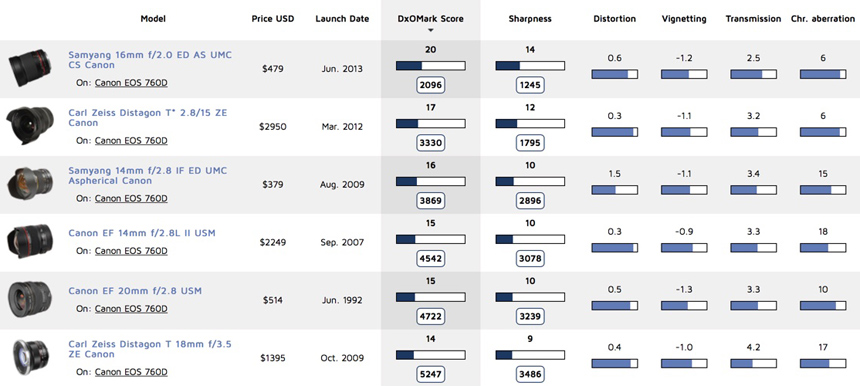
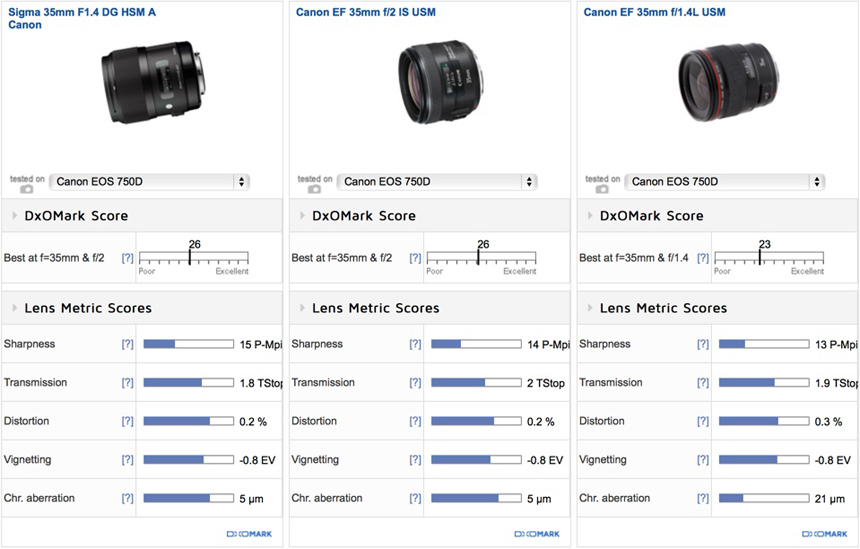
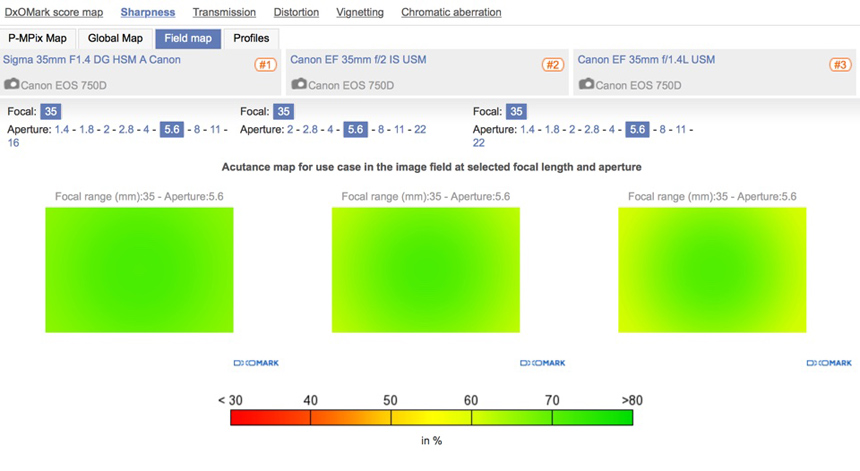
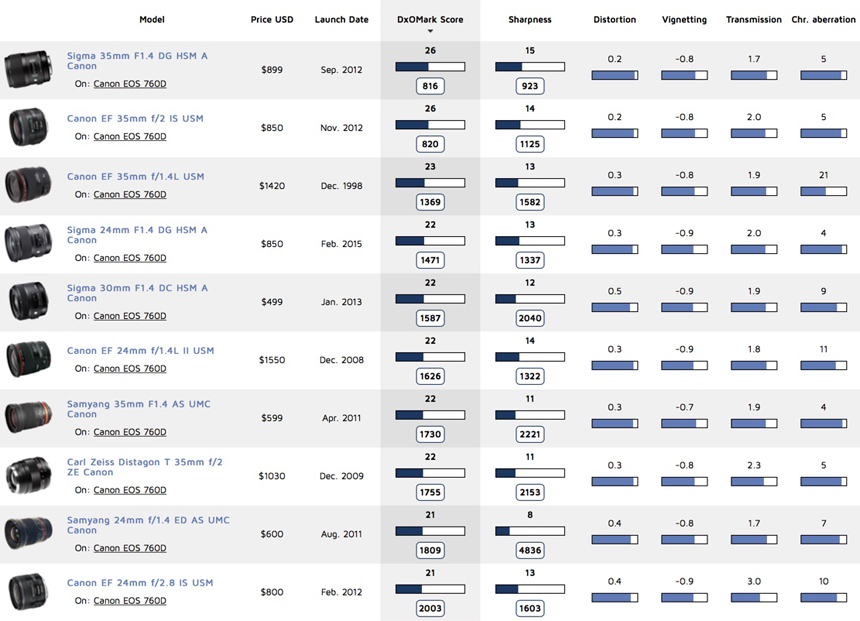
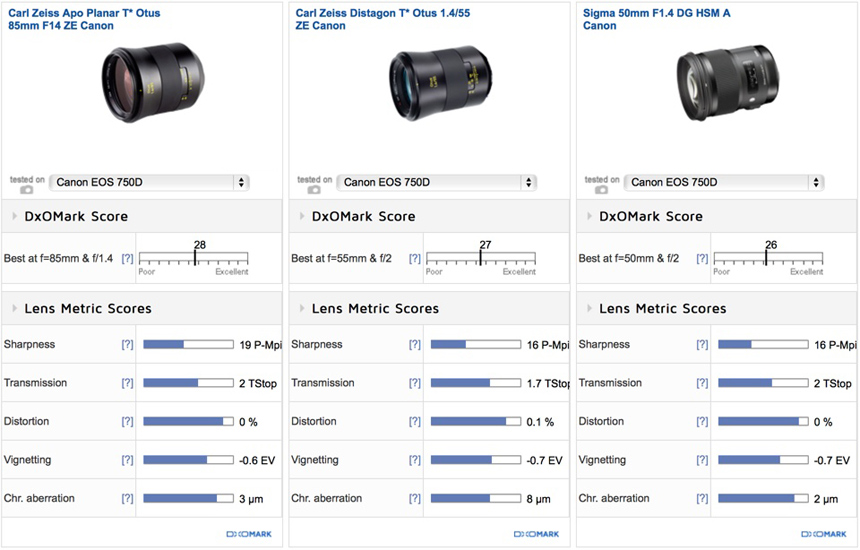
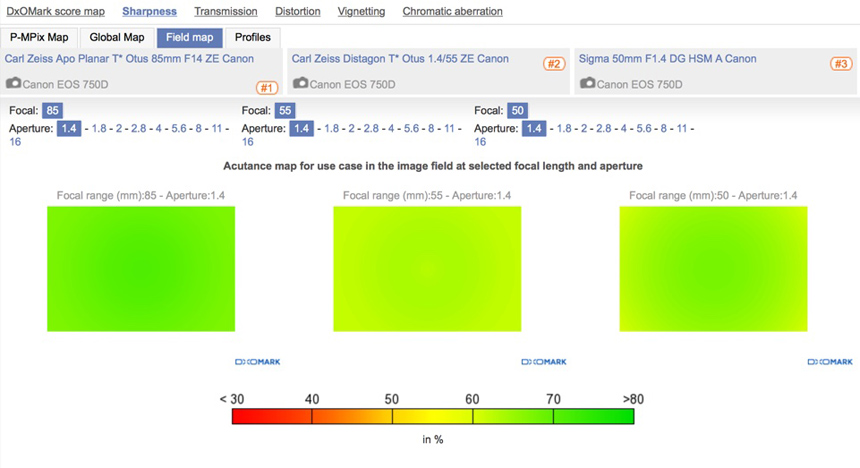
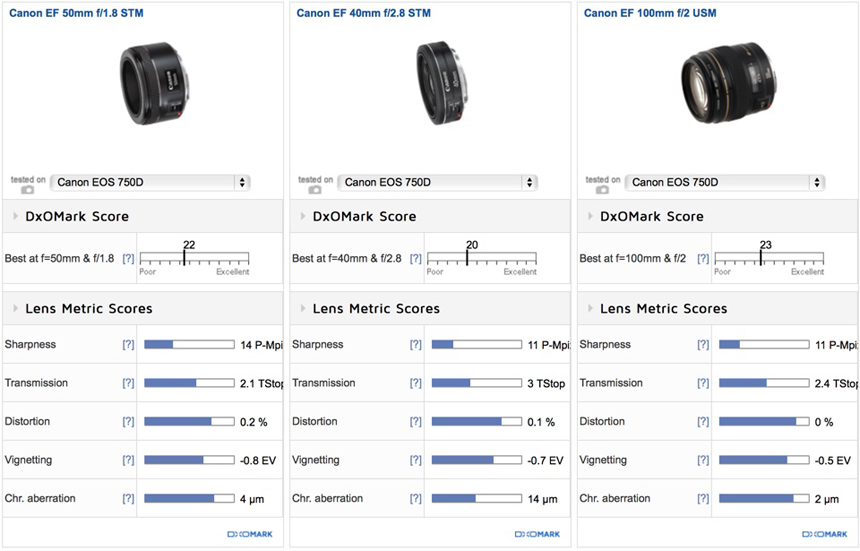
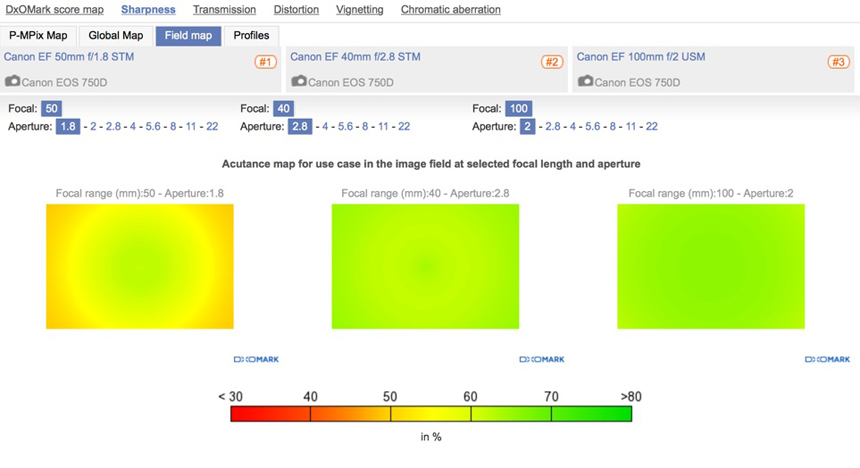
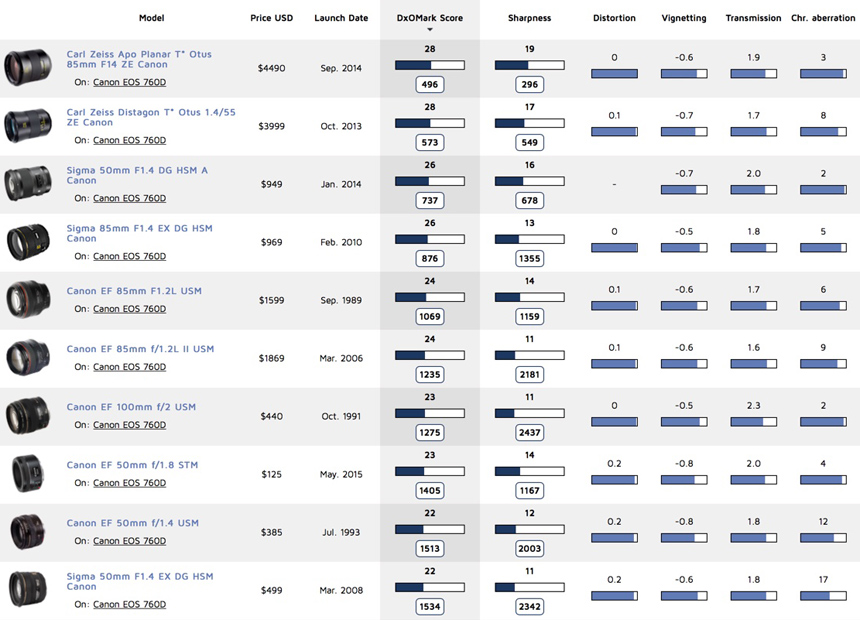
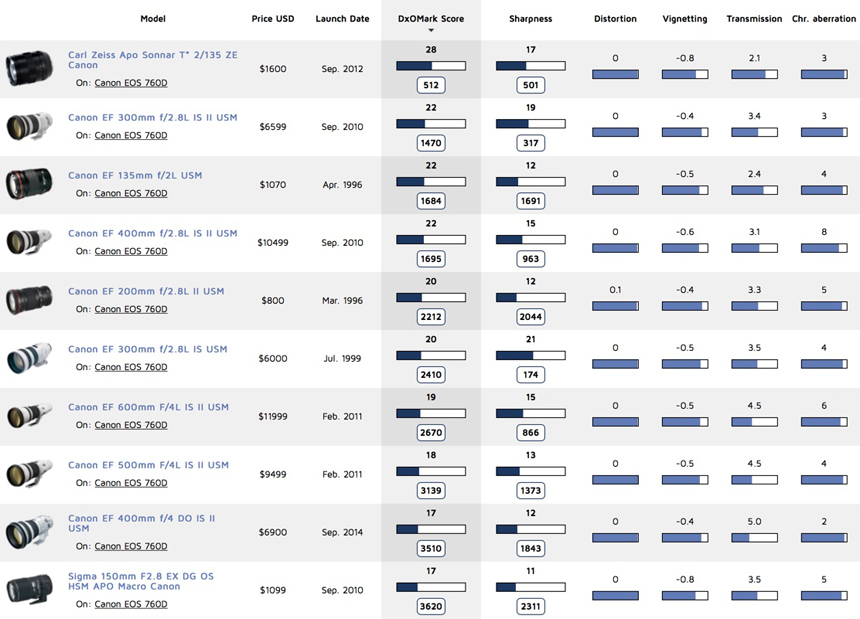
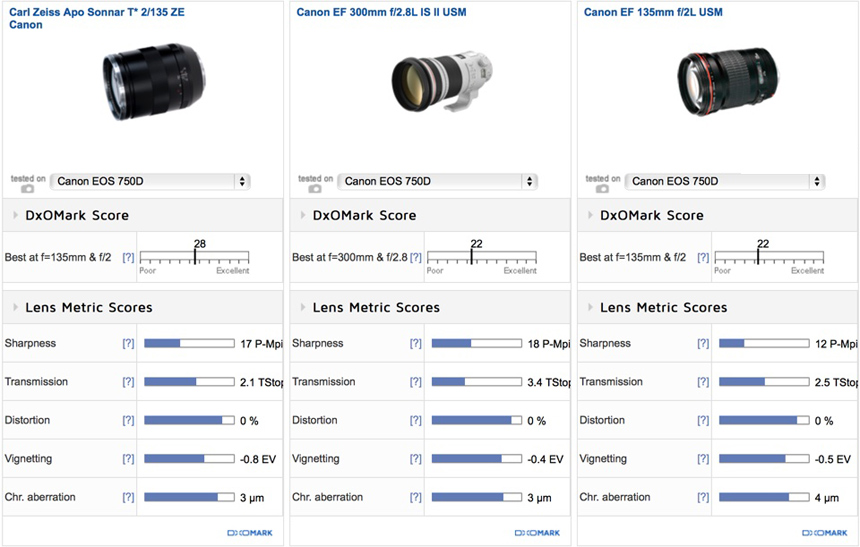
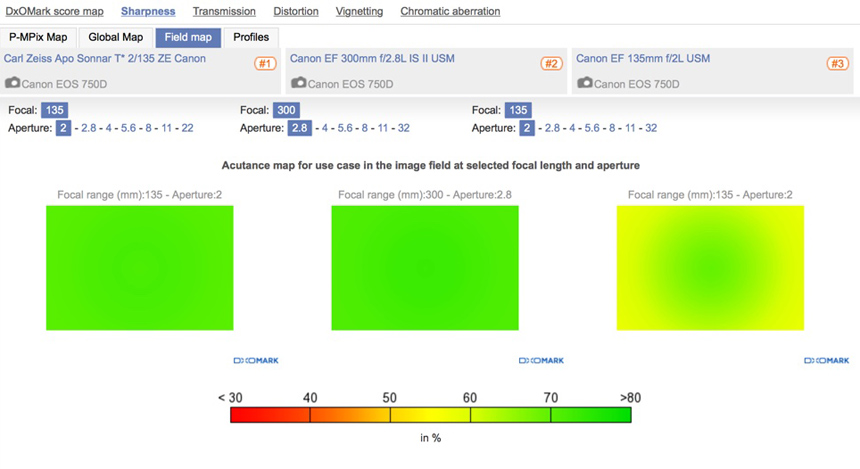
DXOMARK encourages its readers to share comments on the articles. To read or post comments, Disqus cookies are required. Change your Cookies Preferences and read more about our Comment Policy.